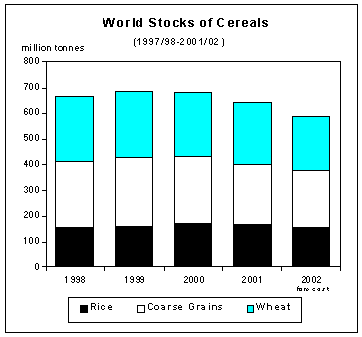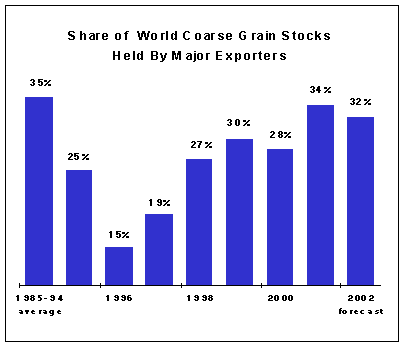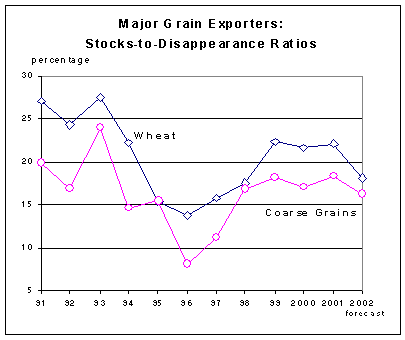The forecast for world cereal carryovers for crop years ending 2002 has been raised to 587 million tonnes, up 34 million tonnes from the previous report but still 55 million tonnes, or 8 percent, below the previous season's level. This season's decline would be mainly on account of a reduction in China's inventories due to smaller wheat and rice harvests. The increase in this month's forecast reflects larger than expected stock build-ups in India, the Russian Federation and Ukraine, while higher stocks are also anticipated in Australia and the EC. World wheat stocks, by the close of the seasons ending in 2002, are now forecast to reach 211 million tonnes, up 11 million tonnes from the December forecast but still 26 million tonnes, or 11 percent, below their opening levels. The anticipated decline in end-of-season wheat stocks in China would account for most of the year-to-year reduction in world carryovers. Also, aggregate wheat stocks in major exporting countries are currently forecast to decline by 11 million tonnes to 41 million tonnes. The decline is some 4 million less than was forecast earlier, mostly reflecting this month's upward adjustments to 2001 production numbers in Australia and the EC.

|
Crop year ending in:
|
|||
|
2000
|
2001 estimate
|
2002 forecast
|
|
|
(. . . . million tonnes . . .)
|
|||
|
Wheat
|
251.5
|
237.1
|
211.5
|
|
Coarse grains
|
261.2
|
239.6
|
223.6
|
|
of which:
|
|
|
|
|
Maize
|
212.9
|
197.5
|
179.2
|
|
Barley
|
25.5
|
22.2
|
21.9
|
|
Sorghum
|
7.9
|
6.1
|
7.2
|
|
Others
|
14.9
|
13.7
|
15.4
|
|
Rice (milled)
|
167.9
|
165.2
|
151.5
|
|
TOTAL
|
680.6
|
641.9
|
586.5
|
Source: FAO
The forecast of smaller ending stocks held by the major exporting countries would also bring down the ratio of their aggregate wheat stocks to their total disappearance (the sum of their domestic consumption and exports), to 18.2 percent, a relatively low ratio compared to 22.2 percent in 2000/01. However, above-average supplies resulting from good harvests in many other countries, especially India and the Russian Federation but also Hungary, Kazakhstan, Romania, and Ukraine, would largely offset any negative impact on global supplies resulting from smaller major exporters' stocks.

The forecast for world coarse grain inventories for crop years ending in 2002 has been raised by 10 million tonnes since the previous report to 224 million tonnes. This month's higher forecast reflects larger than expected inventories in Australia, the EC, and the Russian Federation. However, based on the current forecast, world carryover stocks would still be some 16 million tonnes below their opening levels, largely due to significant drawdowns in China and the United States, and in spite of higher stockpiles in a number of other countries, most notably the Russian Federation, Ukraine and Hungary. Larger inventories are also expected in Brazil because of a record maize crop. Overall, coarse grain inventories in Africa are envisaged to recede mostly in view of lower maize supplies in the southern subregion.

Coarse grain stocks held by major exporters are likely to fall to 72 million tonnes, down 9 million tonnes from the previous season. At this level, the ratio of major exporters' stocks to their total disappearance is likely to drop to 16.3 percent in 2001/02, compared to 18.4 percent in 2000/01. The reduction is mostly triggered by a likely contraction of inventories in the United States, following a cut in 2001 production. By contrast, coarse grain inventories in the EC are likely to increase for the third consecutive year, as supplies continue to outpace demand, especially with regards to rye, which has become increasingly uncompetitive compared to barley and wheat.

FAO's forecast for world rice stocks at the close of the marketing seasons
ending in 2002 has been raised substantially from the last issue, from 138.9
million tonnes to 151.5 million tonnes. Sizeable adjustments have also been
made to the stock figures of years 2000 and 2001. Those revisions mainly reflected
new estimates of the rice inventories of India and, to a smaller extent, Thailand
and Viet Nam. In the case of Viet Nam, the variations were associated with the
shift to a new base for reporting the rice season. For 2002, at the new forecast
level, global rice inventories could be 14 million tonnes smaller than in the
previous year. Although traditional importing countries' share in the total
is relatively small, at 12 percent, it is noteworthy that, according to FAO
estimates, the size of their stocks is forecast to decline by over 2 million
tonnes, to 17.7 million tonnes, which would mark a change in the direction observed
since 1998. At the same time, rice holdings by major rice exporting countries
are anticipated to shrink to 133.8 million tonnes, the lowest level since 1998.
The expected decline in global rice inventories reveals that growth in world
production would fail to keep pace with consumption requirements again this
year. This would be especially the case in China, where the draw-down could
exceed 11 million tonnes. The contraction in 2001 production is also likely
to result in much smaller stocks at the close of the season in Brazil, Cambodia,
Indonesia and Pakistan. By contrast, rice inventories are forecast to be much
greater than previously anticipated in India, because of the good 2001
crop and record high opening stocks. The revision for the country follows the
release of a figure of 24.8 million tonnes held by Government agencies at the
close of last season, on 30 September 2001, which is much higher than previously
forecast. Such large rice stocks in public stores can be explained by the relatively
high procurement prices paid by Government agencies and depressed offtake from
Government stores. The increase in production in 2001 is also expected to boost
closing stocks in Bangladesh, the Republic of Korea and the United States. Little
change is anticipated for the other major rice producing countries, including
Thailand, Viet Nam and the Philippines.